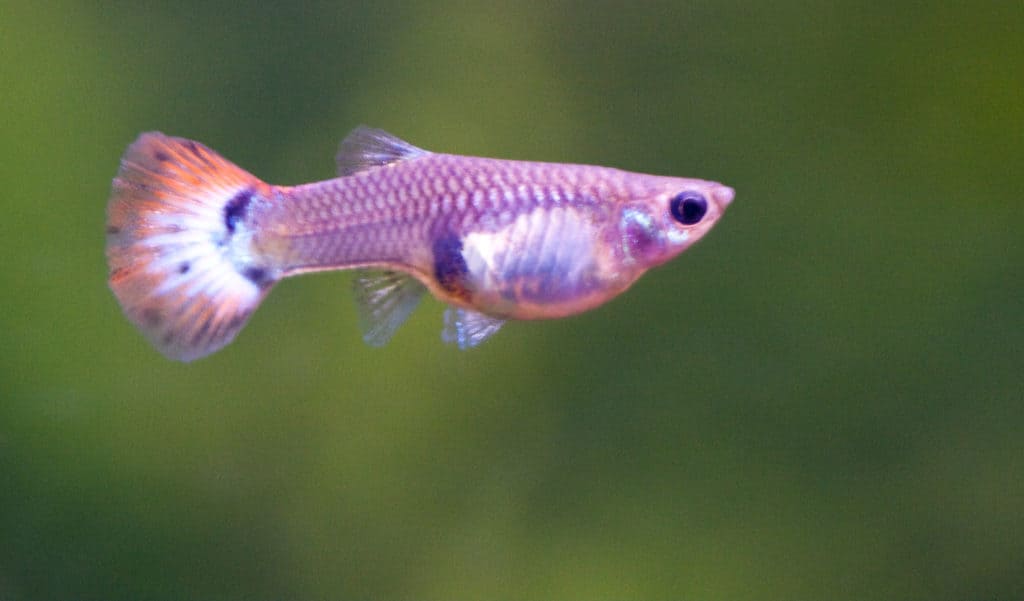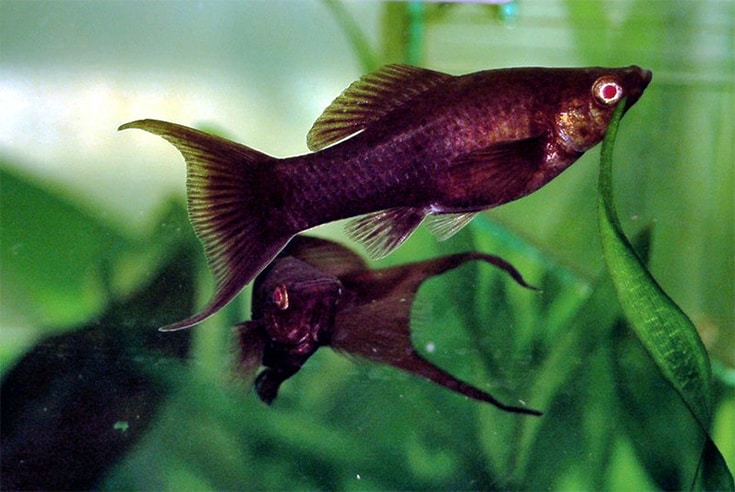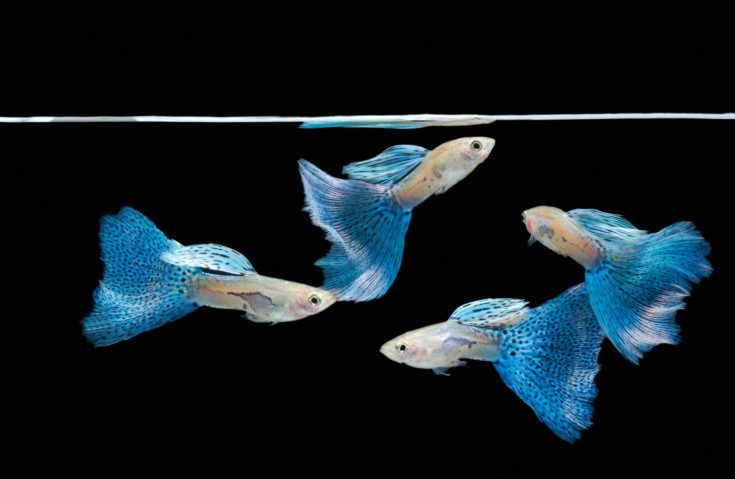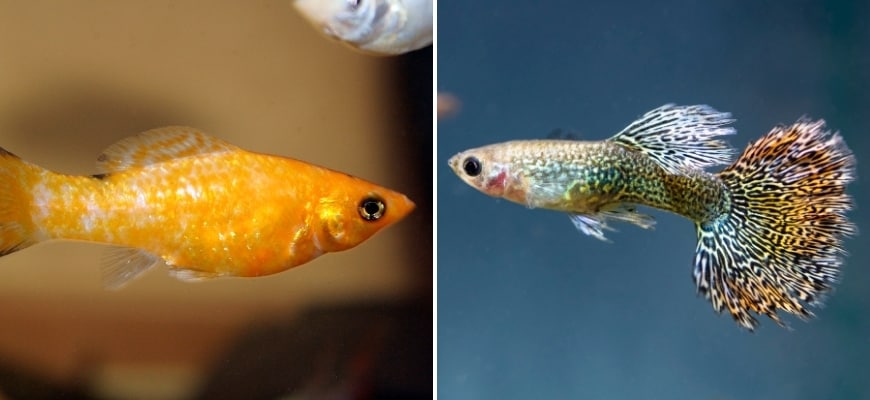Mollies and Guppies are extremely popular tropical aquarium fish that are suitable for newbies to the hobby.
Both species are brightly colored, active livebearers that can add fun and vibrancy to any aquarium setup. And these pretty fish are incredibly easy to breed, too, bringing a whole new dimension to your fishkeeping journey.
But can Guppies and Mollies live together as compatible tank mates?
Read this guide to find out!
Can Guppies And Mollies Live Together?
In short, yes, Guppies and Mollies can get along fine together and they generally make very good tank mates for a peaceful community setup.
However, the success of the combination will depend on the individual fish and the nature of your setup.
Similar Traits Of Guppies And Mollies
One of the reasons that these two species make suitable tank mates is that they have quite a few similar traits:
- Guppies and Mollies share the same genus, Poecilia, which also contains Endler’s Livebearers.
- Within each species are many different varieties.
- The two sexes of both Guppies and Mollies are very easily distinguishable.
- Mollies and Guppies are both livebearers.
- Both species are small, active, peaceful fish.
- Both Guppies and Mollies are considered to be easy to care for.
- Guppies and Mollies eat a similar diet.
- Both species live in a similar habitat and tolerate similar water conditions.
Possible Competition
Unfortunately, those similar traits can lead to problems.
In many cases, when two different species use the same resources within their environment, such as food sources and territory, competition can cause aggression between them. You can get around that by keeping a large tank and watch the fish carefully at feeding times for signs of aggression.
Also, many Guppy varieties have long, flowing finnage, which can encourage fin nipping. Since Guppies are much smaller than mollies, bullying can sometimes be a problem.
Do Guppies And Mollies Get Along?
As previously mentioned, yes, generally, Guppies and Mollies get along pretty well.


Both species share similar behaviors, especially eating live food, nibbling on live plants, breeding, and exploring every area of the tank. Guppies and Mollies are both open water or surface feeders and prefer a densely planted environment with a moderate current.
Guppies and Mollies are highly social with their own kind and are lively, busy little fish. You’ll also notice that these fish can be quite interactive, hurrying to the viewing pane when you approach the tank, especially at feeding times.
Poecilia species can live and breed in freshwater, although they do enjoy brackish conditions.
Potential Cross Breeding Between Guppies And Mollies
Mollies and Guppies are prolific breeders, to say the least! If you have one male and one female of the same species, you’re guaranteed a brood of babies in no time. And that’s great, as it means you’ll most likely never need to buy more fish!
No Need For Males!
Although both species reproduce sexually, sometimes, you don’t even need fish of the opposite sex in the tank to produce babies. How so?
Well, that’s because of an amazing evolutionary quirk that enables female Mollies and Guppies to store sperm from a previous mating, so the fish can become pregnant without the need for a male in the tank! Mollies can store viable sperm for up to three months, whereas shorter-lived Guppies can do so for the rest of their lives. So, in theory, even if you only bought female fishes home from the pet store, you could finish up with several broods of fry, even if you never put a male fish in the aquarium!
Inter-species Breeding
Although Mollies and Guppies are different species, they share the same genus, much like horses and donkeys. That means that, although preferring members of their own kind as breeding partners, it is entirely possible for two different species to interbreed. For example, a male donkey and female horse hybrid is called a mule.
So, if you were to keep only female Mollies and male Guppies, there is a slim chance that they would breed, although that’s rare. The offspring of a Molly and a Guppy generally have a Molly’s body shape and Guppy coloring and are smaller than a purebred Molly.
Male To Female Ratio
As I said, both species are prolific breeders, and that can lead to problems. Male Guppies will harass a female to try to mate with her, sometimes until she dies of exhaustion. And male Mollies are just as guilty of that behavior.
To keep over enthusiastic males in check, I recommend that you keep at least two females to one male, preferably more. That male-to-female ratio gives the females a chance to rest between pregnancies and prevents stress-related diseases from breaking out in the tank.
Guppy And Molly Fry Care
Guppies generally breed every 30 days, giving birth to between 20 to 50 live fry each time. Mollies also breed every 30 days, producing between ten and 60 fry.
But don’t worry, your tank will not become overpopulated, as both Mollies and Guppies eat their young if given a chance, as will your other omnivorous tank residents. That said, I’ve had many baby guppies survive to adulthood in a heavily planted tank with lots of cover where the fry can hide in safety as they grow.
If you want to keep the fry, you need to remove them from the tank as soon as they’re born and grow them in a separate tank. When newly born, the fry will feed on infusoria and other microorganisms in the tank. Once they’re large enough, the babies can be fed crushed tropical fish flakes.
How Can I Stop My Mollies And Guppies From Breeding?
You can’t! It’s as simple as that. Mollies and Guppies breed constantly.
However, you can reduce the chances of breeding by keeping the tank temperature at the lower end of their tolerance. Although, good luck with that; these guys are insatiable!
Feeding Guppies And Mollies
Fortunately, Guppies and Mollies eat pretty much the same diet, which makes life easier if you keep the two species together.
These fish are both omnivores, meaning that they eat both plant matter and meaty protein. Any algae that are growing in your tank will provide a food source, as will some of your plants. You can also offer the fish some blanched veggies as a supplementary treat.
Also, both these species of aquarium fish enjoy live food. Live mosquito larvae, daphnia, and brine shrimp are all good choices. All these foods provide the fish with the nutrition that they need, as well as adding interest to the environment by giving the fish something to chase.
Make sure that you source your live foods from a reputable pet store, never from nature, as live foods can introduce disease or bacteria to your aquarium.
Staple Diet
For a staple diet, you should feed your Guppies and Mollies a high-quality fish flake food. Flakes contain all the nutrients and added vitamins that your fish need to remain healthy and thrive.
Be careful not to overfeed your fish. Mollies and Guppies will eat whenever food is put in the tank, and that can cause health problems in the long term. Also, uneaten food causes waste to accumulate in the tank.
Feed your fish twice a day in small portions, only offering what they will clear in a couple of minutes.
Keeping Right Water Parameters
For both fish species to remain healthy and free from stress, you need to make sure that the water parameters are correct. Fortunately, Guppies and Mollies share similar requirements when it comes to water parameters.
The preferred water parameters for Guppies are:
- Water temperature: 72° to 82° F
- pH: 6.8 to 7.8
- Water hardness: 8 to 12 dGH
The preferred water parameters for Mollies are:
- Water temperature: 75° to 80° F
- pH: 7.0 to 8.0
- Water hardness: 15 to 302 dGH
So, both species can tolerate similar water conditions.
Frequent Water Changes
For your Guppies and Mollies to thrive and remain healthy, you need to keep the tank clean and the water safe and free from ammonia and nitrites.
So, you should use an aquarium vacuum to remove uneaten food, fallen plant matter, and fish waste from the substrate and between the plant bases. Also, weekly 20% to 30% water changes are necessary to prevent nitrates from accumulating that will harm your fish.
Population Control
Overcrowding can lead to aggression, stress, and poor water quality. So, make sure that you don’t try to keep too many fish in your tank.
Guppies need a tank of a minimum of 10 gallons so that they have plenty of space to swim. However, Mollies grow to measure around 4 inches in length, making them considerably larger than Guppies, so they need a bigger tank of at least 20 gallons.

Don’t worry too much about your tank becoming overpopulated as a result of the fish breeding. Most of the fry will be eaten by other adult fish.
Habitat And Tank Requirements
Guppies and Mollies share similar habitat and tank requirements.
As mentioned above, Guppies are somewhat smaller than Mollies, so they will be happy in a 10-gallon nano tank. However, your Mollies need a larger aquarium. To be safe, I recommend that you buy a tank of at least 20 gallons if you want to keep both of these species, although a larger aquarium is even better if you have the space for one in your home.
A long tank is better than a tall one for these fish, as they are both very lively, active swimmers that need plenty of space to move around.
Guppies and Mollies
Guppies come from South America where they live in freshwater rivers and streams. The habitat contains lots of dense vegetation and is shaded by overhanging trees. Mollies are found in similar habitats in Mexico.
These fish need to feel safe and secure, so they need plenty of places to hide. So, when furnishing a tank for Guppies and Mollies, you should include lots of bushy plants, driftwood, caves, and rocky overhangs. Floating plants work well, too, as they provide excellent shelter for fry and help to diffuse the tank lighting, creating a natural environment for the fish.
As regards a substrate, Mollies prefer a sandy substrate, whereas Guppies are indifferent.
So, you can see that both species enjoy a similar tank environment.
Temperaments
Guppies and Mollies are pretty compatible when it comes to their preferred tank conditions. But how do they match up on temperament?
Guppy Temperament
Guppies are generally more peaceful than mollies, so you’ll have no concerns about them fighting or harassing other members of your community.
That said, if you have too many male guppies in the tank and too few females, the boys can get angsty with each other. Ideally, you want a minimum of one male guppy for every two females, although if you’re going to include more females, so much the better.
Guppies are extremely active little creatures that spend much of their time cruising around the top and middle areas of the water column. If your Guppies tend to hide away a lot, observe the tank to see if there’s a bully in the mix and remove the culprit if necessary.
Molly Temperament

Mollies are peaceful fish, but they can be belligerent if kept in a tank that’s too small or overcrowded. An aggressive Molly will most likely pick on your Guppies, especially as the male Guppy’s bright colors and flowing tail will catch the Mollies’ attention.
When keeping Mollies, you need to have more females than males to prevent the females from being harassed. Alternatively, since male and female Mollies are pretty similar in color, you might want to keep a school of only females.
Mollies are very active fish that gravitate to the top and middle of the water column, where they will mingle happily with other members of the community.
In Conclusion

I hope you enjoyed our guide to the compatibility of Guppies and Mollies. Don’t forget to share it if you did!
Guppies and Mollies belong to the same species and share similar requirements when it comes to water parameters and tank conditions. Both species are livebearers and prolific breeders, regularly producing a lot of fry, although most of the babies will be eaten by their parents and other fish in the aquarium. These bright, colorful fish share similar behaviors and dietary requirements, too, making them pretty compatible tank mates.
If you have Guppies and Mollies in your tank, did they interbreed? Tell us in the comments box below!